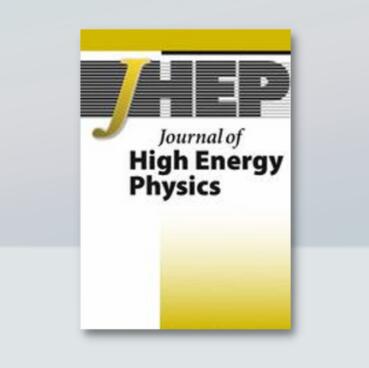关于开闭弦振幅的归一化
IF 5.5
1区 物理与天体物理
Q1 Physics and Astronomy
引用次数: 0
摘要
利用开闭弦场论的分解约束,确定了开闭弦外态下一般弦振幅的符号和归一化。所有振幅的归一化由格数、边界数、开闭弦插入数、弦耦合和d膜张力控制。符号的挑战出现了,因为相关的模空间不是复杂的流形,没有明显的方向。我们通过对模空间上的积分测度的符号固定一个特定的约定来处理这个问题,并对相关器内的算子和虚插入的排序采用一致的规定。本文章由计算机程序翻译,如有差异,请以英文原文为准。
On the normalization of open-closed string amplitudes
We use the factorization constraints of open-closed string field theory to determine the signs and normalizations of general string amplitudes with both open and closed string external states. The normalization of all amplitudes is controlled by the genus, the number of boundaries, the number of open and closed string insertions, the string coupling and the D-brane tension. The challenge with signs arises because the relevant moduli spaces are not complex manifolds and have no obvious orientation. We deal with this by fixing a specific convention for the sign of the integration measure over the moduli space and adopting a consistent prescription for the ordering of operators and ghost insertions inside correlators.
求助全文
通过发布文献求助,成功后即可免费获取论文全文。
去求助
来源期刊

Journal of High Energy Physics
物理-物理:粒子与场物理
CiteScore
10.30
自引率
46.30%
发文量
2107
审稿时长
1.5 months
期刊介绍:
The aim of the Journal of High Energy Physics (JHEP) is to ensure fast and efficient online publication tools to the scientific community, while keeping that community in charge of every aspect of the peer-review and publication process in order to ensure the highest quality standards in the journal.
Consequently, the Advisory and Editorial Boards, composed of distinguished, active scientists in the field, jointly establish with the Scientific Director the journal''s scientific policy and ensure the scientific quality of accepted articles.
JHEP presently encompasses the following areas of theoretical and experimental physics:
Collider Physics
Underground and Large Array Physics
Quantum Field Theory
Gauge Field Theories
Symmetries
String and Brane Theory
General Relativity and Gravitation
Supersymmetry
Mathematical Methods of Physics
Mostly Solvable Models
Astroparticles
Statistical Field Theories
Mostly Weak Interactions
Mostly Strong Interactions
Quantum Field Theory (phenomenology)
Strings and Branes
Phenomenological Aspects of Supersymmetry
Mostly Strong Interactions (phenomenology).
 求助内容:
求助内容: 应助结果提醒方式:
应助结果提醒方式:


